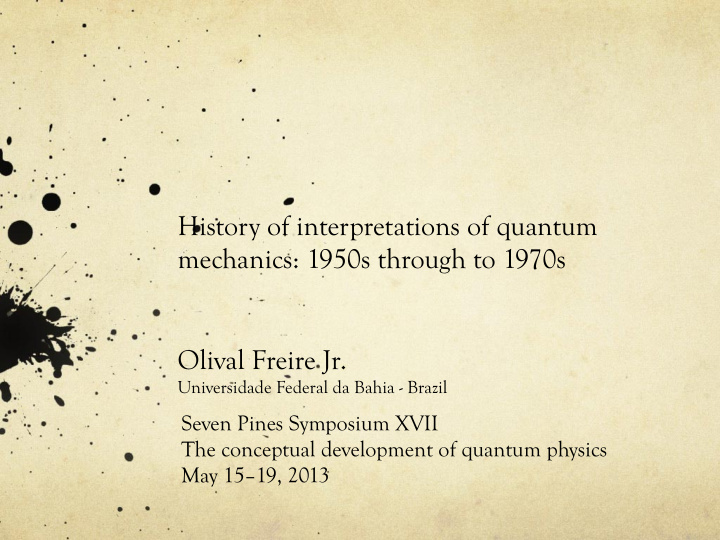



History of interpretations of quantum mechanics: 1950s through to 1970s Olival Freire Jr. Universidade Federal da Bahia - Brazil Seven Pines Symposium XVII The conceptual development of quantum physics May 15–19, 2013
Outline: The 1950s - Bohm & Everett The 1960s - Measurement & Bell theorem The 1970s – Experimental blossoming & interpretations Nowadays – The inconvenient truth
The 1950s … � The intellectual landscape concerning interpretations of quantum theory has dramatically changed � Complementarity no longer reigns alone and alternative interpretations have begun to appear. � Two American physicists, David Bohm and Hugh Everett, were the main protagonists challenging the received views on the interpretation of Quantum Theory (QT).
David Bohm (1917-1992) � Criticized the abandonment of determinism and the well defined properties in the quantum domain. � Built a model for electrons taking them as bodies with a position and momentum simultaneously well defined. He was able to reproduce results obtained by QT in the non-relativistic domain. � His interpretation received both the technical name of “hidden variables” and the more philosophically inclined “causal interpretation”. � Poorly received, then abandoned by himself, and later taken up by others, it was revived in different strands.
Hugh Everett (1930-1982) � Everett built his interpretation dispensing with the second kind of evolution of quantum states that von Neumann had taught would govern measurements. � Measurement ruled by the Schrödinger equation through relative states � Disliked the complementarity assumption that quantum physics requires the use of classical concepts while limiting their use in the quantum domain. � Work badly received in Copenhagen, he pursued neither it nor physics as a whole. � Revived from the late 1960s on in different strands and research programs
The 1960s … The mid 1960s was not a time for new interpretations � Instead, it was the time for research and quarrels around the � quantum measurement problem: Wigner versus Rosenfeld & Italians (DLP), Shimony, d’Espagnat, Ludwig … Bohm’s interpretation produced offspring: Bell’s theorem � and the beginning of ‘experimental metaphysics’ Cultural and political unrest of the late 60s led to the � blossoming of its ‘hundred flowers’: the Varenna school, the revival of Everett’s interpretation, debates in Physics Today, …
The 1970s … The puzzle of the first experiments with Bell’s theorem � The solution of the puzzle and corroboration of quantum � entanglement The number of alternative interpretations of QT continues to � grow … and nowadays there is a plethora of different interpretations Almost all of them are empirically equivalent, at least in the non � relativistic domain Experimental tests have discarded a few categories of � interpretations (hidden variables implying local realism, non contextual, …) However, the most interesting interpretations have survived these � tests
Since then … � Increasing technical capabilities continue to confirm quantum predictions in the most extreme experimental situations: Entanglement and its diverse variants (GHZ, quantum � teleportation, etc.) Manipulation of single systems, such as electrons, � photons, neutrons, and atoms Measurement of decoherence times � Bose-Einstein condensates � Aharonov-Bohm effect � First quantum computers �
Nowadays: An inconvenient truth � Never were there so many equivalent interpretations, never was quantum theory so confirmed � Interpretations have become an industry for physicists and philosophers, populating many technical journals and books � However, they are notably absent from physics teaching and from most of the research on physics teaching � How to deal with such a situation, particularly in the presentation of quantum theory for wider audiences and in the introductory quantum physics teaching?
Two choices to face this truth: 1) To present it as a temporary result and say that future experiments will settle the controversy To foster new experiments is part of physics business � But it seems naïve to hope for such a settling, it has yet � to occur Or, 2) to present the inconvenient truth – the existence of rival but equivalent interpretations – as a real part of physics Philosophers, logicians, and historians may help us as � they are familiar with this kind of issue. Indeed, the plethora of quantum interpretations is one of the most telling examples of the so-called Duhem-Quine thesis: the underdetermination of theories by the empirical data.
Duhem-Quine Thesis Pierre Duhem (1861-1916): The aim and Structure of Physical Theory (French edition, 1906) If a theory is contradicted … it is a conjunction of hypothesis that is refuted Willard Van Orman Quine (1908-2000) Two Dogmas of Empiricism (1951) There is much latitude of choice as to what statements to reevaluate in the light of any single contrary experience
Duhem-Quine Thesis Afterthoughts 1994 1976
� The challenge lies in sophisticating the way we present quantum physics: Make explicit the diversity of equivalent interpretations � Emphasize the level of empirical corroboration of � quantum theory mainly through current experiments However, experimental advances may not settle the � controversy: Duhem- Quine thesis is a good portrait of real science Choice of quantum interpretations has been a practical � matter. It is a good example of how physicists select theories: not only empirical corroboration and internal consistency. Cognitive reasons such as empirical evidence; generalization; mathematical consistency; physics consistency; beauty; simplicity; rich source to approach different problems; but also cultural contingencies such as philosophical presumptions; cultural and professional trends.
Recommend
More recommend